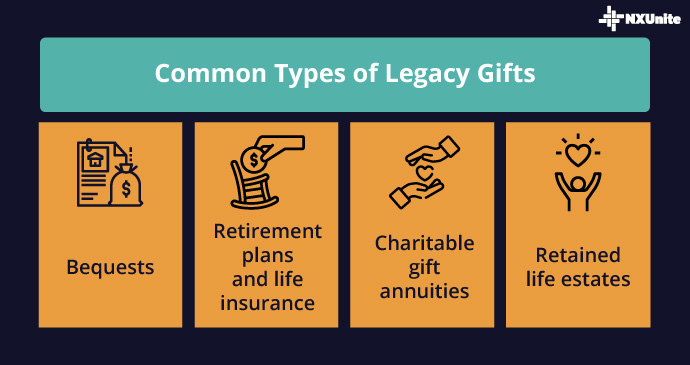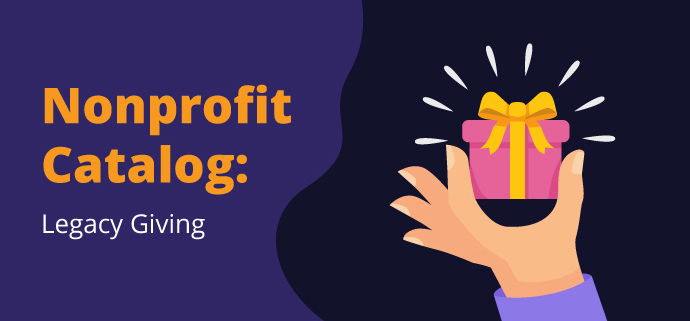Legacy Giving – Nonprofit Catalog
Legacy giving is a unique fundraising opportunity that can be ongoing like other development work, such as seeking major gifts or grants, and can also access an untapped source of donations. This type of gift is important to your donors who want to leave a lasting legacy and positive impact on your mission as it allows them to give larger donations at a future date.
Before you plan how to incorporate legacy giving into your fundraising strategy, let’s review the basics:
What is legacy giving?
Legacy giving, or planned giving, is a donation that has been incorporated into the donor’s financial or estate plan, usually to be given after they pass away.
This is typically a large donation that can provide significant funds to a nonprofit and tax benefits to the donor or the donor’s family. Legacy gifts or planned gifts are often unrestricted, although donors can specify particular programs or projects that their gifts will need to go towards.

Types of legacy gifts
Legacy gifts are unique in that they’re non-cash. In other words, they’re given out of assets or overall estates rather than day-to-day income. Donors can often give larger planned gifts than they’d be able to purely out of pocket. There are numerous ways to plan a gift to a nonprofit, so there are options to accommodate each situation. Consider these key types of legacy gifts:
Bequests: A legacy gift where the donor includes a nonprofit in their will, leaving a portion of their estate to it.
Retirement plans and life insurance: A legacy gift where the donor leaves their unused retirement assets to a nonprofit or names the nonprofit as the beneficiary of their life insurance policy.
Charitable gift annuities: A legacy gift where the donor gives a large donation in exchange for a fixed income payment.
Retained life estates: A legacy gift where the donor transfers ownership of their property to a nonprofit but retains the right to use it until the set term is up.
Only a donor can decide which type of legacy gift works best for their situation, goals, and plans. Make sure your supporters understand their options so they can choose and customize their gifts accordingly once you start a conversation with them about planned giving.
Legacy giving FAQ
Who is eligible to give a legacy gift?
Anyone is eligible to give a legacy gift, but people who have a will, life insurance policy, property, or other significant assets are more likely to give. Because there are so many types of these gifts, the parameters are wide, but these donors at least have to have something to give. Donors with proven wealth make ideal first prospects, but even lifelong savers who might not otherwise be on your radar as top prospects can make significant legacy contributions if you put in the work of developing your relationships with them and explaining the impact they could have.
To narrow down this donor pool, you might research a prospect’s involvement with your cause, such as past giving or volunteering. You can also survey your supporters to learn more about their interest in legacy gifts and your organization. Some of your supporters might have already included your nonprofit in their will.
What is the most common type of legacy gift?
Bequests are the most popular type of legacy gift. They’re typically easier to arrange than other gifts, since wills are easy to update. Providing easy-to-use estate planning tools to your bequest prospects can help you secure more planned gifts.
Many people may choose to give via bequest but won’t tell your nonprofit about their gift. This is why a survey can be helpful to identify existing donors or people who might be interested in planned giving.
Why are legacy gifts important to the nonprofit?
Nonprofits benefit from legacy gifts financially. These donations can be considered long-term income for a nonprofit because they promise future funding that can be projected and planned on to support future growth. They can also be invested in some cases to return even more funding.
It’s a gift that will support the nonprofit for years without requiring extra expenses from the nonprofit, making planned giving among the highest-ROI fundraising activities. Rather than hosting a gala, for example, nonprofits might secure legacy gifts by simply making their supporters aware of planned giving as an option and reaching out to prospects to discuss it. It’s a promise of future funding that can come from nearly any supporter at little or no cost to your organization.
How does a legacy gift benefit the donor?
Depending on the type of legacy gift, donors might not feel the financial effects of giving in their lifetime. Because they don’t interrupt daily cash flow, they provide an opportunity to give a large gift to a cause the donor is passionate about. Leaving such a gift can make the donor feel like they’ve left an impactful legacy.
The reduced day-to-day burden is helpful, but there are also financial incentives to legacy giving. Some gift types, like bequests and charitable remainder trusts, offer significant tax benefits for donors and/or their heirs. The donor is given the flexibility to develop a planned gift that best suits their financial situations and desired outcomes.
Legacy giving gives control to the donor in more ways than one. Not only can the donor choose which type of gift they’d prefer to give, but they can also decide what’s done with that gift. For example, in a bequest, the donor might allocate their money to a specific cause or project.
How can nonprofits start promoting legacy gifts?
Even if you have a clear understanding of legacy gifts and the potential impact they would have for your organization, your supporters might not. The best way to promote legacy gifts is to make donors aware of their options.
You might find opportunities to bring up legacy giving in conversations with top prospects, or you might send out communications to your supporter base specifically about these types of gifts. No matter what, make it as easy as possible for your supporters to explore their options and plan their gift. Offer easy to use tools for creating bequests, like Freewill. Over time, you can develop a dedicated planned giving program that sources, cultivates, and stewards new legacy gifts for your nonprofit.
Additional Resources
Nonprofit Catalog – Read up on more nonprofit essentials by exploring our Nonprofit Catalog.
Nonprofit Marketing – Learn more about the basics of nonprofit marketing and how to structure your marketing strategy.
A Guide to Planned Giving – Take a deeper dive into planned giving and how to get started.


